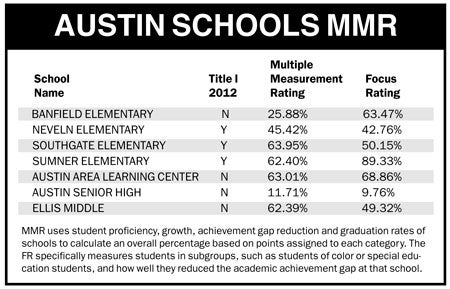Austin showing positive signs on AYP, MMR scores
Published 10:54 am Thursday, August 30, 2012
The numbers are looking promising for Austin Public Schools.
The district’s Adequate Yearly Progress and scores on Multiple Measurement Ratings and Focus Ratings all showed improvement over the previous year when the Minnesota Department of Education released its latest test results Thursday.
Sumner Elementary School made AYP across the board this year, and its ratings were in the top 40 among schools that accept Title I poverty funding statewide. No Austin school made AYP last year.
“There wasn’t really a lot that was unexpected,” said John Alberts, educational services director of Austin Public Schools.
As the Minnesota Comprehensive Assessment numbers showed earlier this month, Austin is making great gains in math but weak gains in reading, a trend mirrored in the latest rankings. Yet Austin schools remain below average when it comes to MMR and FR ratings.
MMR data focuses on student growth and reducing the academic achievement gap between white and non-white/non-privileged students. The MMR benchmark reflects how well students did based on the academic growth shown in last year’s MCA scores, the graduation rate for those years, the achievement gap between white and non-white or non-privileged students, and whether students are meeting new MCA score benchmarks.
There’s also a Focus Rating, which determines how well schools focus on lowering the achievement gap. State officials use the same achievement gap data under the MMR while also looking at how well non-white and non-privileged students performed on the MCA.
With so much data, it’s difficult to single out immediate concerns or triumphs, but district officials are pleased with most of what they see. Sumner’s MMR rating improved to 62.4 percent this year, and its FR is at 89.33 percent.
Under MMR, most of Minnesota’s 2,000 public schools received an overall numerical ranking, but only about a quarter — those schools receiving federal poverty aid — got one of five designations: Reward, Celebration, Continuous Improvement, Focus and Priority.
Schools with the Priority, Focus and Continuous Improvement designations must come up with plans to show improvement and will have to set aside 20 percent of their federal poverty aid to launch those plans.
Overall, the new system gives school more flexibility in implementing those plans. Only Priority and Focus schools must have their plans approved by the state Education Department.
There are no reward schools in Mower County based on last year’s data. Sumner’s successful growth makes it eligible for Celebration school status, though Alberts said the district would have to apply for that status. On the other hand, Southgate was labeled a focus school in the spring, when MMR benchmark data based on 2010 and 2011 MCA scores were released.
Though the district’s relatively new math curriculum and new online MCA math test meant Austin’s math scores dramatically increased — 16.9 percent compared to the 7.9 percent state average — the district’s reading scores are relatively weak, with only 1 or 2 percent growth in some schools.
“We do know that we need to make improvements in reading,” Alberts said.
Alberts points to the new Mondo curriculum, which focuses on reading skills and aural connections to reading comprehension, as a means to increase reading skills. The Mondo curriculum will be used in all Austin elementary schools this year, as Sumner saw positive results as a pilot school for the initiative last year.
In addition, there’s more reading intervention opportunities at Ellis Middle School and Austin High School, which Alberts said should improve reading scores as well.
District officials will pour over the data next month, making changes to school site plans after they also look at student benchmark data from preliminary testing done to see what academic level students are at. Benchmark testing will take place next month as well, since most Austin students start school Tuesday, Sept. 4.
—The Minneapolis Star Tribune contributed to this report.






